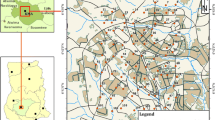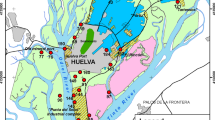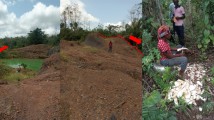Abstract
Geostatistical analysis and GIS-based spatial mapping have been widely used for risk assessment of environmental pollution. The objectives of this study were to: (1) investigate the spatial variability of pseudototal concentrations of Cd, Pb, and Zn; (2) estimate the degree of contamination on the basis of pollution indexes; and (3) combine geostatistical analysis with oral bioaccessibility to better assess the population’s exposure to metals in smelter-impacted soils. Implications for human health risks were assessed by considering soil as a contaminant source, a release mechanism of contaminated soil to the hands, ingestion as an exposure route, and metal bioaccessibility. The bioaccessibility data in the gastric (G) and gastrointestinal (GI) phases were integrated into the standard hazard quotient-based risk assessment method. Using pollution indices showed that the entire area studied was highly polluted in terms of soil metal concentrations. However, the spatial pattern of health risk levels did not coincide with the spatial distribution of the degree of soil contamination. Introducing the bioaccessible fraction of metals from soils into the exposure calculations resulted in a substantial decrease in calculated risk (HI, hazard index) and provided a more realistic estimate of exposure to the three metals. For the highly exposed population, 46 % of the soils studied provided an HI-G > 1.0 and 15 % provided an HI-GI > 1.0, suggesting probable adverse health effects in children. The present study highlights the importance of conducting studies taking into account metal bioaccessible values in risk assessment.




Similar content being viewed by others
References
Appleton, J. D., Cave, M. R., & Wragg, J. (2012). Modelling lead bioaccessibility in urban topsoils based on data from Glasgow, London, Northampton and Swansea, UK. Environmental Pollution, 171, 265–272.
Barsby, A., McKinley, J. M., Ofterdinger, U., Young, M., Cave, M. R., & Wragg, J. (2012). Bioaccessibility of trace elements in soils in Northern Ireland. Science of the Total Environment, 433, 398–417.
Basta, N. T., & Gradwohl, R. (2000). Estimation of Cd, Pb, and Zn bioavailability in smelter-contaminated soils by a sequential extraction procedure. Journal of Soil Contamination, 9, 149–164.
Bermudez, G. M. A., Jasan, R., Pla, R., & Pignata, M. L. (2011). Heavy metal and trace element concentrations in wheat grains: Assessment of potential non-carcinogenic health hazard through their consumption. Journal of Hazardous Materials, 193, 264–271.
Bourennane, H., Salvador-Blanes, S., Cornu, S., & King, D. (2003). Scale of spatial dependence between chemical properties of topsoil and subsoil over a geologically contrasted area (Massif Central, France). Geoderma, 112, 235–251.
Calabrese, E. J., Stanek, E. J., James, R. C., & Roberts, S. M. (1997). Soil ingestion: A concern for acute toxicity in children. Environmental Health Perspectives, 105, 1354–1358.
Cave, M. R., Wragg, J., Denys, S., Jondreville, C., & Feidt, C. (2011). Oral bioavailability. In F. A. Swarjtes (Ed.), Dealing with contaminated sites, from theory towards practical application (pp. 287–384). New York: Springer.
Chen, T., Zheng, Y., Lei, M., Huang, Z., Wu, H., Chen, H., et al. (2005). Assessment of heavy metal pollution in surface soils of urban parks in Beijing, China. Chemosphere, 60, 542–551.
Chilès, J. P., & Delfiner, P. (1999). Geostatistics: Modelling spatial uncertainty (p. 720). New York: Wiley.
Davis, H. T., Aelion, C. M., McDermott, S., & Lawson, A. B. (2009). Identifying natural and anthropogenic sources of metals in urban and rural soils using GIS-based data, PCA, and spatial interpolation. Environmental Pollution, 157, 2378–2385.
Day, J. P., Fergusson, J. E., & Chee, T. M. (1979). Solubility and potential toxicity of lead in urban street dust. Bulletin of Environmental Contamination and Toxicology, 23, 497–502.
Denys, S., Caboche, J., Tack, K., Rychen, G., Wragg, J., Cave, M., Jondreville, C., & Feidt, C. (2012). In vivo validation of the unified BARGE method to assess the bioaccessibility of arsenic, antimony, cadmium, and lead in soils. Environmental Science and Technology, 46, 6252–6260.
Douay, F., Pelfrêne, A., Planque, J., Fourrier, H., Richard, A., Roussel, H., et al. (2013). Assessment of potential health risk for inhabitants living near a former lead smelter. Part 1: Metal concentrations in soils, agricultural crops, and homegrown vegetables. Environmental Monitoring and Assessment, 185, 3665–3680.
Douay, F., Pruvot, C., Roussel, H., Ciesielski, H., Fourrier, H., Proix, N., et al. (2008). Contamination of urban soils in an area of Northern France polluted by dust emissions of two smelters. Water, Air, and Soil Pollution, 188, 247–260.
Douay, F., Pruvot, C., Waterlot, C., Fritsch, C., Fourrier, H., Loriette, A., et al. (2009). Contamination of woody habitat soils around a former lead smelter in the North of France. Science of the Total Environment, 407, 5564–5577.
Doyle, J. R., Blais, J. M., Holmes, R. D., & White, P. A. (2012). A soil ingestion pilot study of a population following a traditional lifestyle typical of rural or wilderness areas. Science of the Total Environment, 424, 110–120.
DRIRE (2003). L’industrie au regard de l’environnement (p. 308). Douai: Direction Régionale de l’Industrie de la Recherche et de l’Environnement.
Duggan, M. J., Inskip, M. J., Rundle, S. A., & Moorcroft, J. S. (1985). Lead in playground dust and on hands of schoolchildren. Science of the Total Environment, 44, 65–79.
Ettler, V., Kříbek, B., Majer, V., Knésl, I., & Mihaljevič, M. (2012). Differences in the bioaccessibility of metals/metalloids in soils from mining and smelting areas (Copperbelt, Zambia). Journal of Geochemical Exploration, 113, 68–75.
Fritsch, C., Giraudoux, P., Coeurdassier, M., Douay, F., Raoul, F., Pruvot, C., et al. (2010). Spatial distribution of metals in smelter-impacted soils of woody habitats: Influence of landscape and soil properties, and risk for wildlife. Chemosphere, 81, 141–155.
Gbefa, K., Entwistle, J. A., & Dean, J. R. (2011). Oral bioaccessibility of metals in an urban catchment, Newcastle upon Tyne. Environmental Geochemistry and Health, 33, 167–181.
Gong, M., Wu, L., Bi, X. Y., Ren, L. M., Wang, L., Ma, Z. D., et al. (2010). Assessing heavy-metal contamination and sources by GIS-based approach and multivariate analysis of urban–rural topsoils in Wuhan, central China. Environmental Geochemistry and Health, 32, 59–72.
Goovaerts, P. (1999). Geostatistics in soil science: State-of-the-art and perspectives. Geoderma, 89, 1–45.
Guagliardi, H., Cicchella, D., & De Rosa, R. (2012). A geostatistical approach to assess concentration and spatial distribution of heavy metals in urban soils. Water, Air, and Soil Pollution, 223, 5983–5998.
Hamel, S. C., Ellickson, K. M., & Lioy, P. J. (1999). The estimation of the bioaccessibility of heavy metals in soils using artificial biofluids by two novel methods: Mass-balance and soil recapture. Science of the Total Environment, 244, 273–283.
Hough, R. L., Breward, N., Young, S. D., Crout, N. M. J., Tye, A. M., Moir, A. M., et al. (2004). Assessing potential risk of heavy metal exposure from consumption of home-produced vegetables by urban populations. Environmental Health Perspectives, 112, 215–221.
JECFA (2010). Joint FAO/WHO expert commited on food additives. Seventy-third meeting, Geneva, 8–17 June 2010, Summary and conclusions.
Juhasz, A. L., Smith, E., Weber, J., Rees, M., Rofe, A., Kuchel, T., et al. (2007). Comparison of in vivo and in vitro methodologies for the assessment of arsenic bioavailability in contaminated soils. Chemosphere, 69, 961–966.
Juhasz, A. L., Weber, J., & Smith, E. (2011). Impact of soil particle size and bioaccessibility on children and adult lead exposure in peri-urban contaminated soils. Journal of Hazardous Materials, 186, 1870–1879.
Karadas, C., & Kara, D. (2011). In vitro gastro-intestinal method for the assessment of heavy metal bioavailability in contaminated soils. Environmental Science and Pollution Research, 18, 620–628.
Krivoruchko, K. (2011). Spatial statistical data analysis for GIS users (p. 928). Redlands: ESRI Press.
Li, X., & Feng, L. (2012). Multivariate and geostatistical analyzes of metals in urban soil of Weinan industrial areas, Northwest of China. Atmospheric Environment, 47, 58–65.
Lin, Y. P. (2002). Multivariate geostatistical methods to identify and map spatial variations of soil heavy metals. Environmental Geology, 42, 1–10.
Maas, S., Scheifler, R., Benslama, M., Crini, N., Lucot, E., Brahmia, Z., et al. (2010). Spatial distribution of heavy metal concentrations in urban, suburban and agricultural soils in a Mediterranean city of Algeria. Environmental Pollution, 158, 2294–2301.
Matheron, G. (1970). La théorie des variables régionalisées et ses applications. Les cahiers du centre de morphologie mathématique de Fontainebleau, fascicule 5 (p. 212). Fontainebleau: Ecole des Mines de Paris.
Meza-Montenegro, M. M., Gandolfi, A. J., Santana-Alcántar, M. E., Klimecki, W. T., Aguilar-Apodaca, M. G., Del Río-Salas, R., et al. (2012). Metals in residential soils and cumulative risk assessment in Yaqui and Mayo agricultural valleys, northern Mexico. Science of the Total Environment, 433, 472–481.
Okorie, A., Entwistle, J., & Dean, J. R. (2011). The application of in vitro gastrointestinal extraction to assess oral bioaccessibility of potentially toxic elements from an urban recreational site. Applied Geochemistry, 26, 789–796.
Oliver, M. A. (1997). Soil and human health: A review. European Journal of Soil Science, 48, 573–592.
Oliver, M. A., & Webster, R. (2014). A tutorial guide to geostatistics: Computing and modelling variograms and kriging. Catena, 113, 56–69.
Oomen, A. G., Brandon, E. F. A., Swartjes, F. A., & Sips, A. J. A. M. (2006). How can information on oral bioavailability improve human health risk assessment for lead-contaminated soils? RIVM Report 711701042/2006. The Netherlands: Bilthoven.
Oomen, A. G., Hack, A., Minekus, M., Zeijdner, E., Schoeters, G., Verstraete, W., et al. (2002). Comparison of five in vitro digestion models to study the bioaccessibility of soil contaminants. Environmental Science and Technology, 36, 3326–3334.
Pelfrêne, A., Douay, F., Richard, A., Roussel, H., & Girondelot, B. (2013a). Assessment of potential health risk for inhabitants living near a former lead smelter. Part 2: Site-specific human health risk assessment of Cd and Pb contamination in kitchen gardens. Environmental Monitoring and Assessment, 185, 2999–3012.
Pelfrêne, A., Waterlot, C., & Douay, F. (2011a). In vitro digestion and DGT techniques for estimating cadmium and lead bioavailability in contaminated soils: Influence of gastric juice pH. Science of the Total Environment, 409, 5076–5085.
Pelfrêne, A., Waterlot, C., & Douay, F. (2013b). Influence of land use on bioaccessibility of metals in smelter-impacted soils. Environmental Pollution, 178, 80–88.
Pelfrêne, A., Waterlot, C., Mazzuca, M., Nisse, C., Bidar, G., & Douay, F. (2011b). Assessing Cd, Pb, Zn human bioaccessibility in smelter-contaminated agricultural topsoils (northern France). Environmental Geochemistry and Health, 33, 477–493.
Pelfrêne, A., Waterlot, C., Mazzuca, M., Nisse, C., Cuny, D., Richard, A., et al. (2012). Bioaccessibility of trace elements as affected by soil parameters in smelter-contaminated agricultural soils: A statistical modeling approach. Environmental Pollution, 160, 130–138.
Poggio, L., Vrščaj, B., Schulin, R., Hepperle, E., & Marsan, F. A. (2009). Metals pollution and human bioaccessibility of topsoils in Grugliasco (Italy). Environmental Pollution, 157, 680–689.
Pruvot, C., Douay, F., Fourrier, H., & Waterlot, C. (2006). Heavy metals in soil, crops and grass as a source of human exposure in the former mining area. Journal of Soils and Sediments, 6, 215–220.
Roussel, H., Waterlot, C., Pelfrêne, A., Pruvot, C., Mazzuca, M., & Douay, F. (2010). Cd, Pb and Zn oral bioaccessibility of urban soils contaminated in the past by the atmospheric emissions of two lead and zinc smelters. Archives of Environmental Contamination and Toxicology, 58, 945–954.
Ruby, M. V., Davis, A., Schoof, R., Eberle, S., & Sellstone, C. M. (1996). Estimation of lead and arsenic bioavailability using a physiologically based extraction test. Environmental Science and Technology, 30, 422–430.
Sterckeman, T., DOuay, F., Proix, N., & Fourrier, H. (2000). Vertical distribution of Cd, Pb and Zn in soils near smelters in the North of France. Environmental Pollution, 107, 377–389.
Sterckeman, T., Douay, F., Proix, N., Fourrier, H., & Perdrix, E. (2002). Assessment of the contamination of cultivated soils by eighteen trace elements around smelters in the North of France. Water, Air, and Soil Pollution, 135, 173–194.
Sun, Y., Zhou, Q., Xie, X., & Liu, R. (2010). Spatail, sources and risk assessment of heavy metal contamination of urban soils in typical regions of Shenyang, China. Journal of Hazardous Materials, 174, 455–462.
USEPA. (1989). Risk assessment guidance for superfund, vol I: Human health evaluation manual; EPA/540/1-89/002. Washington, DC: Office of Soils Waste and Emergency Response.
USEPA (2007). Integrated risk information system-database. Philadelphia PA; Washington, DC.
USEPA. (2008). A probabilistic risk assessment for children who contact CCA-treated playsets and decks. Washington, DC: A.D. Office of pesticide programs.
Van de Wiele, T. R., Oomen, A. G., Wragg, J., Cave, M., Minekus, M., Hack, A., et al. (2007). Comparison of five in vitro digestion models to in vivo experimental results: Lead bioaccessibility in the human gastrointestinal tract. Journal of Environmental Science and Health A, 42, 1203–1211.
Wang, X., Sato, T., Xing, B., & Tao, S. (2005). Health risks of heavy metals to the general public in Tianjin, China via consumption of vegetables and fish. Science of the Total Environment, 350, 28–37.
Wei, B., Jiang, F., Li, X., & Mu, S. (2009). Spatial distribution and contamination assessment of heavy metals in urban dust from Urumqi, NW, China. Microchemical Journal, 93, 147–152.
Wei, B., & Yang, L. (2010). A review of heavy metal concentrations in urban soils, urban roads dusts and agricultural soils from China. Microchemical Journal, 94, 99–107.
Wixson, B. G., & Davies, B. E. (1994). Guidelines for lead in soil: Proposal of the society of environmental geochemistry and health. Environmental Science and Technology, 28, 26–31.
Wragg, J., Cave, M. R., Basta, N., Brandon, E., Casteel, S. E. B., Denys, S., et al. (2011). An inter-laboratory trial of the unified BARGE bioaccessibility method for arsenic, cadmium and lead in soil. The Science of the Total Environment, 409, 4016–4030.
Yang, J. K., Barnett, M. O., Jardine, P. M., & Brooks, S. C. (2003). Factors controlling the bioaccessibility of arsenic(V) and lead(II) in soil. Soil & Sediment Contamination, 12, 165–179.
Zhang, H., Huang, G. H., & Zeng, G. P. (2009a). Health risks from arsenic-contaminated soil in Flin Flon–Creighton, Canada: Integrating geostatistical simulation and dose-response model. Environmental Pollution, 157, 2413–2420.
Zhang, X. Y., Lin, F. F., Wong, M. T. F., Feng, X. L., & Wang, K. (2009b). Identification of soil heavy metal sources from anthropogenic activities and pollution assessment of Fuyang County, China. Environmental Monitoring and Assessment, 154, 439–449.
Zhao, Y., Wang, Z., Sun, W., Huang, B., Shi, X., & Ji, J. (2010). Spatial interrelations and multi-scale sources of soil heavy metal variability in a typical urban–rural transition area in Yangtze river delta region of China. Geoderma, 156, 216–227.
Zhao, H., Xia, B., Fan, C., Zhao, P., & Shen, S. (2012). Human health risk from soil heavy metal contamination under different land uses near Dabaoshan Mine, Southern China. Science of the Total Environment, 417–418, 45–54.
Acknowledgments
The authors wish to thank the Nord-Pas de Calais Council and ADEME (French Agency for the Environment and Energy Management, Angers, France) for the financial support of this research as part of the BIOMIS and BIOAC programs. We are grateful for the valuable comments of our two anonymous reviewers.
Author information
Authors and Affiliations
Corresponding author
Rights and permissions
About this article
Cite this article
Pelfrêne, A., Détriché, S. & Douay, F. Combining spatial distribution with oral bioaccessibility of metals in smelter-impacted soils: implications for human health risk assessment. Environ Geochem Health 37, 49–62 (2015). https://doi.org/10.1007/s10653-014-9629-0
Received:
Accepted:
Published:
Issue Date:
DOI: https://doi.org/10.1007/s10653-014-9629-0




